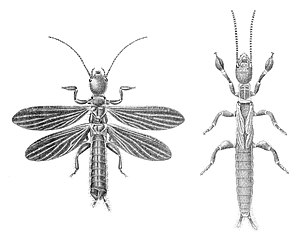Tares spinner
| Tares spinner | ||||||||||||
|---|---|---|---|---|---|---|---|---|---|---|---|---|

|
||||||||||||
| Systematics | ||||||||||||
|
||||||||||||
| Scientific name | ||||||||||||
| Embioptera | ||||||||||||
| Lameere , 1900 |

The embioptera (Embioptera), even heels Spinner called, are an order of insects and are among the winged insects (Pterygota). Together with the stonefly they form a taxon called stonefly-like (Plecopteroida). Some systematists also assume a closer relationship with the ground lice . The approximately 360 known species are mainly found in the tropics , less often in the subtropics . Most species are 8 to 15 millimeters long. The largest representatives are the species of the genus Clothoda with a body length of about 20 millimeters.
features
Tar moth are small, cylindrically shaped insects. The males of most tarsus moths have four about the same size, narrow wings with very simple veins, which are folded back over the body in the rest position. The wings are usually soft and flexible with hollow, uncured veins. If they are to be used for flight (usually only for migrations or to find a partner), they are stabilized by pumped-in hemolymphs. The females are wingless. The thickened legs of the animals are striking. The first tarsal link of the forelegs in particular is heavily thickened and equipped with numerous spinning glands that open into hollow bristles . The three breast segments ( thorax ) are approximately the same size. The animals have long antennae and small compound eyes on their heads . The mouthparts are chewing-biting and show pronounced sexual dimorphism . In the males they are transformed into clamp organs for copulation . The abdomen ends in a pair of short abdomen threads, the cerci .
Way of life
The tares moth live in webs on the ground, which are often laid out under stones. At night the larvae and the females leave the web to search for food. The males are able to produce sounds by rubbing the antennae and use them to woo the females. The fertilized eggs are released into the web in which the larvae also live.
Fossil evidence
The oldest fossil evidence of tarsus spiders comes from Burmese amber from the Middle Cretaceous; due to the already strongly derived morphology of these finds, a higher age (possibly from the Triassic) is assumed. Other finds come from Baltic amber ( Eocene ). The few specimens preserved in fossil form are males of the genus Electroembia , including an individual of the species Electroembia antiqua , the males of which are wingless. Further finds of tar spiders of other genera are known from the younger amber deposits of the Dominican Republic , Mexico ( Chiapas amber ) and from Zanzibar (Tanzania).
Families, genera and species in Europe
The following families, genera and species occur in Europe:
-
Embiidae
-
Cleomia
Stefani , 1953
- Cleomia guareschi Stefani , 1953
-
Embia Latreille , 1825
- Embia amadorae Ross , 196
- Embia cynthiae Fontana , 2002
- Embia fuentei Navàs , 1918
- Embia girolamii Fontana , 2001
- Embia nuragica Stefani , 1953
- Embia ramburi Rimsky-Korsakov , 1905
- Embia savignyi Westwood , 1837
- Embia tyrrhenica Stefani , 1953
-
Cleomia
Stefani , 1953
-
Oligotomidae
-
Haploembia Verhoeff , 1904
- Haploembia palaui Stefani , 1955
- Haploembia solieri ( Rambur , 1842)
-
Haploembia Verhoeff , 1904
References
- ↑ Michael S. Engel & David A. Grimaldi (2006): The Earliest Webspinners (Insecta: Embiodea). American Museum Novitates 3514: 1-15.
- ↑ George O. Poinar, Jr .: Life in Amber . 350 pp., 147 figs., 10 plates, Stanford University Press, Stanford (Cal.) 1992. ISBN 0-8047-2001-0
- ↑ Wolfgang Weitschat and Wilfried Wichard: Atlas of plants and animals in Baltic amber , 256 p., Numerous. Fig., Pfeil-Verlag, Munich 1998. ISBN 3-931516-45-8
- ↑ Adolf Bachofen-Echt: The amber and its inclusions , 204 p., 188 fig., Springer-Verlag, Vienna 1949
- ↑ Embioptera at Fauna Europaea. Retrieved July 13, 2018
literature
- Bernhard Klausnitzer: Embioptera, tares spinner. In Westheide, Rieger (Hrsg.): Special zoology part 1: single-cell and invertebrate animals. Gustav Fischer Verlag, Stuttgart, Jena 1997; Pages 636-637.